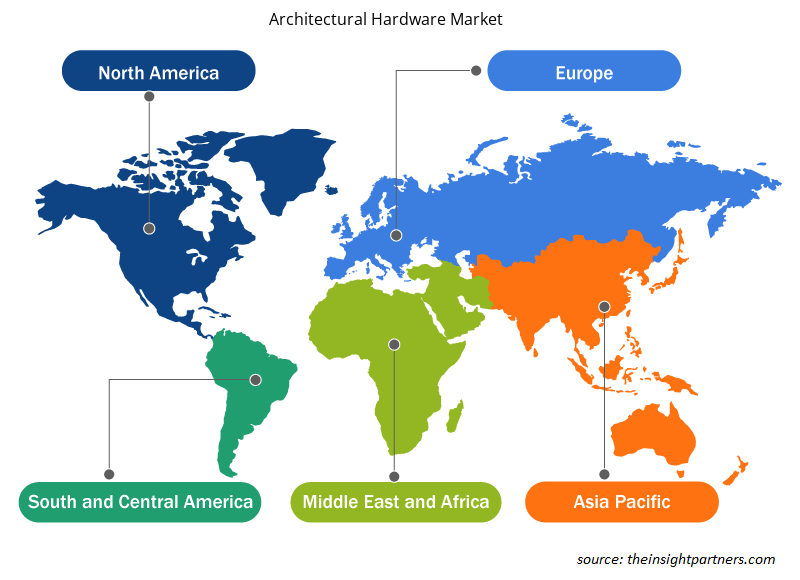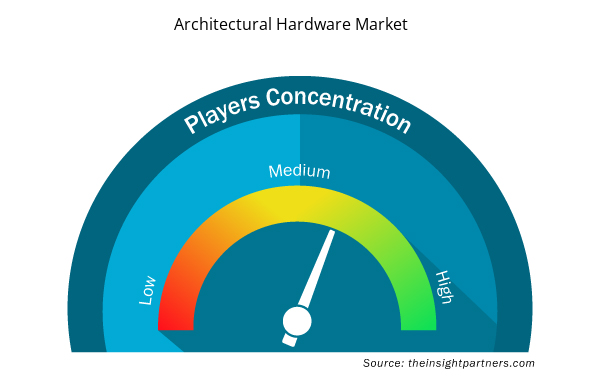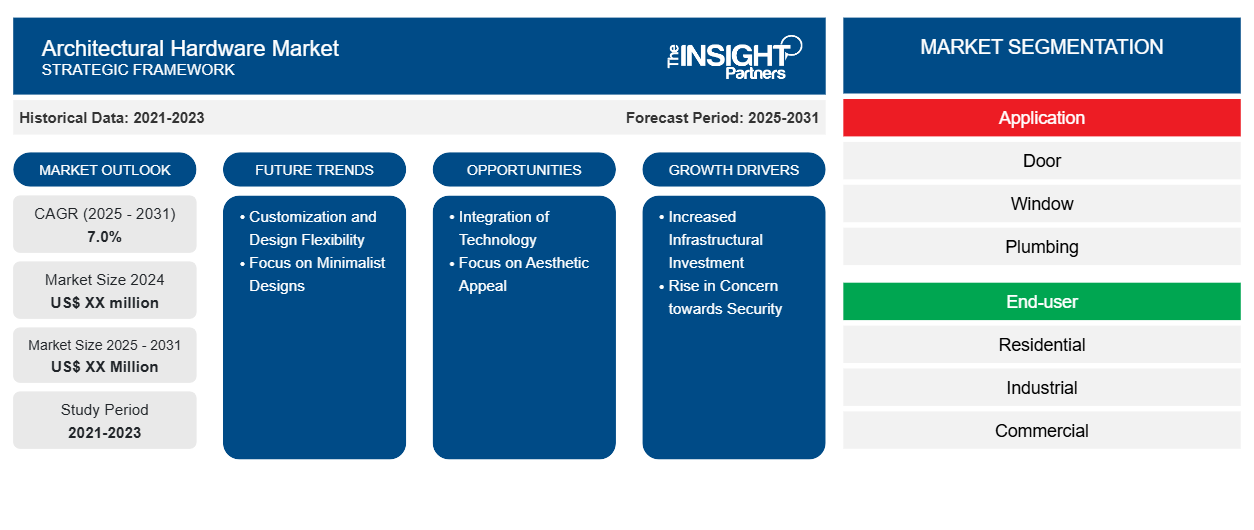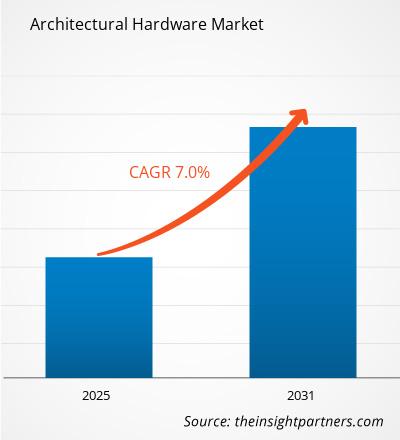Der Markt für Architekturhardware wird voraussichtlich von 2024 bis 2031 eine durchschnittliche jährliche Wachstumsrate (CAGR) von 7,0 % verzeichnen, wobei die Marktgröße von XX Millionen US-Dollar im Jahr 2024 auf XX Millionen US-Dollar im Jahr 2031 wachsen wird.
Der Bericht ist nach Anwendung (Türen, Fenster, Sanitär, Möbel, Sonstiges) segmentiert. Der Bericht präsentiert außerdem Analysen basierend auf dem Endnutzer (Wohn-, Industrie-, Gewerbebereich). Die globale Analyse ist weiter auf regionaler Ebene und nach wichtigen Ländern aufgeschlüsselt. Der Bericht bietet den Wert in USD für die oben genannte Analyse und Segmente.
Zweck des Berichts
Der Bericht „Architectural Hardware Market“ von The Insight Partners zielt darauf ab, die aktuelle Landschaft und das zukünftige Wachstum sowie die wichtigsten treibenden Faktoren, Herausforderungen und Chancen zu beschreiben. Dies wird verschiedenen Geschäftspartnern Einblicke geben, wie zum Beispiel:
- Technologieanbieter/-hersteller: Um die sich entwickelnde Marktdynamik zu verstehen und die potenziellen Wachstumschancen zu kennen, damit sie fundierte strategische Entscheidungen treffen können.
- Investoren: Durchführung einer umfassenden Trendanalyse hinsichtlich der Marktwachstumsrate, der finanziellen Marktprognosen und der Chancen entlang der Wertschöpfungskette.
- Regulierungsbehörden: Zur Regulierung von Richtlinien und Überwachungsaktivitäten auf dem Markt mit dem Ziel, Missbrauch zu minimieren, das Vertrauen der Anleger zu bewahren und die Integrität und Stabilität des Marktes aufrechtzuerhalten.
Marktsegmentierung für Architekturhardware
Anwendung
- Tür
- Fenster
- Sanitär
- Möbel
- Sonstiges
Endbenutzer
- Wohnen
- Industrie
- Kommerziell
Passen Sie diesen Bericht Ihren Anforderungen an
Sie erhalten kostenlose Anpassungen an jedem Bericht, einschließlich Teilen dieses Berichts oder einer Analyse auf Länderebene, eines Excel-Datenpakets sowie tolle Angebote und Rabatte für Start-ups und Universitäten.
- Holen Sie sich die wichtigsten Markttrends aus diesem Bericht.Dieses KOSTENLOSE Beispiel umfasst eine Datenanalyse von Markttrends bis hin zu Schätzungen und Prognosen.
Wachstumstreiber für den Markt für Architekturhardware
- Erhöhte Investitionen in die Infrastruktur: Weitere wichtige Faktoren, die den Markt für Baubeschläge antreiben, sind erhöhte Investitionen in die Infrastruktur. Regierungen und der private Sektor tätigen hohe Investitionen in Wohn- und Nichtwohnprojekte, was die Nachfrage nach einer Vielzahl von Baubeschlägen wie Türen, Fenstern und Möbelbeschlägen erhöht.
- Steigendes Sicherheitsbewusstsein: Das zunehmende Sicherheits- und Komfortbewusstsein in Gebäuden hat zu einer größeren Nachfrage nach den modernsten Hardwarelösungen für die Architektur geführt, wie etwa intelligenten Schlössern und automatisierten Systemen. Dies deutet darauf hin, dass die Verbraucher technologisch fortschrittliche Produkte bevorzugen, um die Sicherheit und Benutzerfreundlichkeit architektonischer Entwürfe zu verbessern.
Zukünftige Trends auf dem Markt für Architekturhardware
- Anpassung und Designflexibilität: Personalisierung und Anpassung sind aktuelle Trends bei Architekturlösungen, die den Herstellern die Möglichkeit bieten, die Wünsche der Verbraucher entsprechend ihren spezifischen Anforderungen zu erfüllen. Viele anpassbare Hardwareoptionen verbessern die Kundenzufriedenheit und verschaffen Marken einen Wettbewerbsvorteil in diesem hart umkämpften Markt.
- Fokus auf minimalistisches Design: Der Schwerpunkt auf minimalistischem und zeitgenössischem Design in der Architektur prägt Trends auf dem Markt für architektonische Hardware. Schlanke, unaufdringliche Hardwarelösungen, die die moderne Ästhetik ergänzen, sind zunehmend gefragt und beeinflussen die Produktentwicklung.
Marktchancen für Architekturhardware
- Integration von Technologie: Die Integration von Technologie in die Produkte ist im Markt für architektonische Hardware ein Trend. In Schlössern und Zugangssystemen werden intelligente Technologien eingesetzt, außerdem werden moderne Materialien verwendet, um Haltbarkeit und Funktionalität zu erhöhen.
- Fokus auf Ästhetik: Die Gestaltung architektonischer Hardware, die neben der Funktionalität auch ästhetisch ansprechend ist, ist zu einem wachsenden Anliegen geworden. Verbraucher verlangen mehr Hardware, die zum modernen Architekturstil passt, und ändern daher Design und Ausführung.
Regionale Einblicke in den Markt für Architekturhardware
Die regionalen Trends und Faktoren, die den Markt für Architekturbeschläge im Prognosezeitraum beeinflussen, wurden von den Analysten von Insight Partners ausführlich erläutert. In diesem Abschnitt werden auch die Marktsegmente und die Geografie für Architekturbeschläge in Nordamerika, Europa, im asiatisch-pazifischen Raum, im Nahen Osten und Afrika sowie in Süd- und Mittelamerika erörtert.

- Erhalten Sie regionale Daten zum Markt für Architekturhardware
Umfang des Marktberichts zu Architekturhardware
| Berichtsattribut | Details |
|---|---|
| Marktgröße im Jahr 2024 | XX Millionen US-Dollar |
| Marktgröße bis 2031 | XX Millionen US-Dollar |
| Globale CAGR (2025 - 2031) | 7,0 % |
| Historische Daten | 2021-2023 |
| Prognosezeitraum | 2025–2031 |
| Abgedeckte Segmente | Nach Anwendung
|
| Abgedeckte Regionen und Länder | Nordamerika
|
| Marktführer und wichtige Unternehmensprofile |
|
Marktdichte von Architekturhardware: Auswirkungen auf die Geschäftsdynamik verstehen
Der Markt für Architekturhardware wächst rasant, angetrieben durch die steigende Nachfrage der Endnutzer aufgrund von Faktoren wie sich entwickelnden Verbraucherpräferenzen, technologischen Fortschritten und einem größeren Bewusstsein für die Vorteile des Produkts. Mit steigender Nachfrage erweitern Unternehmen ihr Angebot, entwickeln Innovationen, um die Bedürfnisse der Verbraucher zu erfüllen, und nutzen neue Trends, was das Marktwachstum weiter ankurbelt.
Die Marktteilnehmerdichte bezieht sich auf die Verteilung der Firmen oder Unternehmen, die in einem bestimmten Markt oder einer bestimmten Branche tätig sind. Sie gibt an, wie viele Wettbewerber (Marktteilnehmer) in einem bestimmten Marktraum im Verhältnis zu seiner Größe oder seinem gesamten Marktwert präsent sind.
Die wichtigsten auf dem Markt für Architekturhardware tätigen Unternehmen sind:
- Allegion PLC
- ASSA ABLOY
- Bohle Limited
- CRH PLC
- Godrej und Boyce
Haftungsausschluss : Die oben aufgeführten Unternehmen sind nicht in einer bestimmten Reihenfolge aufgeführt.

- Überblick über die wichtigsten Akteure auf dem Markt für Architekturhardware
Wichtige Verkaufsargumente
- Umfassende Abdeckung: Der Bericht deckt die Analyse der Produkte, Dienste, Typen und Endbenutzer des Marktes für Architekturhardware umfassend ab und bietet einen ganzheitlichen Überblick.
- Expertenanalyse: Der Bericht basiert auf dem umfassenden Verständnis von Branchenexperten und Analysten.
- Aktuelle Informationen: Der Bericht stellt durch die Abdeckung aktueller Informationen und Datentrends Geschäftsrelevanz sicher.
- Anpassungsoptionen: Dieser Bericht kann angepasst werden, um spezifische Kundenanforderungen zu erfüllen und die Geschäftsstrategien optimal anzupassen.
Der Forschungsbericht zum Markt für Architekturhardware kann daher dabei helfen, die Branchensituation und Wachstumsaussichten zu entschlüsseln und zu verstehen. Obwohl es einige berechtigte Bedenken geben kann, überwiegen die allgemeinen Vorteile dieses Berichts tendenziell die Nachteile.
- Historische Analyse (2 Jahre), Basisjahr, Prognose (7 Jahre) mit CAGR
- PEST- und SWOT-Analyse
- Marktgröße Wert/Volumen – Global, Regional, Land
- Branche und Wettbewerbsumfeld
- Excel-Datensatz


- Vision Guided Robotics Software Market
- Pharmacovigilance and Drug Safety Software Market
- Artificial Intelligence in Healthcare Diagnosis Market
- Sweet Potato Market
- Virtual Production Market
- Toothpaste Market
- HVAC Sensors Market
- Animal Genetics Market
- Water Pipeline Leak Detection System Market
- Intraoperative Neuromonitoring Market

Report Coverage
Revenue forecast, Company Analysis, Industry landscape, Growth factors, and Trends

Segment Covered
This text is related
to segments covered.

Regional Scope
North America, Europe, Asia Pacific, Middle East & Africa, South & Central America

Country Scope
This text is related
to country scope.
Häufig gestellte Fragen
Some of the customization options available based on the request are an additional 3-5 company profiles and country-specific analysis of 3-5 countries of your choice. Customizations are to be requested/discussed before making final order confirmation, as our team would review the same and check the feasibility.
The report can be delivered in PDF/PPT format; we can also share excel dataset based on the request.
The leading players operating in the Architectural Hardware Market include Allegion PLC, ASSA ABLOY, Bohle Limited, CRH PLC, Godrej & Boyce, Häfele GmbH & Co KG, Hettich Holding GmbH & Co. oHG, HOPPE Holding AG, Spectrum Brands Holdings, Inc., Taiwan Fu Hsing Industrial Co., Ltd.
The Architectural Hardware Market is estimated to witness a CAGR of 7.0% from 2023 to 2031
Integration of Technology and Focus on Aesthetic Appeal are the key future trends of the Architectural Hardware Market
The major factors driving the Architectural Hardware Market are: Increased Infrastructural Investment and Rise in Concern towards Security
Trends and growth analysis reports related to Manufacturing and Construction : READ MORE..
The List of Companies
1. Allegion PLC
2. ASSA ABLOY
3. Bohle Limited
4. CRH PLC
5. Godrej and Boyce
6. Häfele GmbH and Co KG
7. Hettich Holding GmbH and Co. oHG
8. HOPPE Holding AG
9. Spectrum Brands Holdings, Inc.
10. Taiwan Fu Hsing Industrial Co., Ltd.
The Insight Partners performs research in 4 major stages: Data Collection & Secondary Research, Primary Research, Data Analysis and Data Triangulation & Final Review.
- Data Collection and Secondary Research:
As a market research and consulting firm operating from a decade, we have published and advised several client across the globe. First step for any study will start with an assessment of currently available data and insights from existing reports. Further, historical and current market information is collected from Investor Presentations, Annual Reports, SEC Filings, etc., and other information related to company’s performance and market positioning are gathered from Paid Databases (Factiva, Hoovers, and Reuters) and various other publications available in public domain.
Several associations trade associates, technical forums, institutes, societies and organization are accessed to gain technical as well as market related insights through their publications such as research papers, blogs and press releases related to the studies are referred to get cues about the market. Further, white papers, journals, magazines, and other news articles published in last 3 years are scrutinized and analyzed to understand the current market trends.
- Primary Research:
The primarily interview analysis comprise of data obtained from industry participants interview and answers to survey questions gathered by in-house primary team.
For primary research, interviews are conducted with industry experts/CEOs/Marketing Managers/VPs/Subject Matter Experts from both demand and supply side to get a 360-degree view of the market. The primary team conducts several interviews based on the complexity of the markets to understand the various market trends and dynamics which makes research more credible and precise.
A typical research interview fulfils the following functions:
- Provides first-hand information on the market size, market trends, growth trends, competitive landscape, and outlook
- Validates and strengthens in-house secondary research findings
- Develops the analysis team’s expertise and market understanding
Primary research involves email interactions and telephone interviews for each market, category, segment, and sub-segment across geographies. The participants who typically take part in such a process include, but are not limited to:
- Industry participants: VPs, business development managers, market intelligence managers and national sales managers
- Outside experts: Valuation experts, research analysts and key opinion leaders specializing in the electronics and semiconductor industry.
Below is the breakup of our primary respondents by company, designation, and region:

Once we receive the confirmation from primary research sources or primary respondents, we finalize the base year market estimation and forecast the data as per the macroeconomic and microeconomic factors assessed during data collection.
- Data Analysis:
Once data is validated through both secondary as well as primary respondents, we finalize the market estimations by hypothesis formulation and factor analysis at regional and country level.
- Macro-Economic Factor Analysis:
We analyse macroeconomic indicators such the gross domestic product (GDP), increase in the demand for goods and services across industries, technological advancement, regional economic growth, governmental policies, the influence of COVID-19, PEST analysis, and other aspects. This analysis aids in setting benchmarks for various nations/regions and approximating market splits. Additionally, the general trend of the aforementioned components aid in determining the market's development possibilities.
- Country Level Data:
Various factors that are especially aligned to the country are taken into account to determine the market size for a certain area and country, including the presence of vendors, such as headquarters and offices, the country's GDP, demand patterns, and industry growth. To comprehend the market dynamics for the nation, a number of growth variables, inhibitors, application areas, and current market trends are researched. The aforementioned elements aid in determining the country's overall market's growth potential.
- Company Profile:
The “Table of Contents” is formulated by listing and analyzing more than 25 - 30 companies operating in the market ecosystem across geographies. However, we profile only 10 companies as a standard practice in our syndicate reports. These 10 companies comprise leading, emerging, and regional players. Nonetheless, our analysis is not restricted to the 10 listed companies, we also analyze other companies present in the market to develop a holistic view and understand the prevailing trends. The “Company Profiles” section in the report covers key facts, business description, products & services, financial information, SWOT analysis, and key developments. The financial information presented is extracted from the annual reports and official documents of the publicly listed companies. Upon collecting the information for the sections of respective companies, we verify them via various primary sources and then compile the data in respective company profiles. The company level information helps us in deriving the base number as well as in forecasting the market size.
- Developing Base Number:
Aggregation of sales statistics (2020-2022) and macro-economic factor, and other secondary and primary research insights are utilized to arrive at base number and related market shares for 2022. The data gaps are identified in this step and relevant market data is analyzed, collected from paid primary interviews or databases. On finalizing the base year market size, forecasts are developed on the basis of macro-economic, industry and market growth factors and company level analysis.
- Data Triangulation and Final Review:
The market findings and base year market size calculations are validated from supply as well as demand side. Demand side validations are based on macro-economic factor analysis and benchmarks for respective regions and countries. In case of supply side validations, revenues of major companies are estimated (in case not available) based on industry benchmark, approximate number of employees, product portfolio, and primary interviews revenues are gathered. Further revenue from target product/service segment is assessed to avoid overshooting of market statistics. In case of heavy deviations between supply and demand side values, all thes steps are repeated to achieve synchronization.
We follow an iterative model, wherein we share our research findings with Subject Matter Experts (SME’s) and Key Opinion Leaders (KOLs) until consensus view of the market is not formulated – this model negates any drastic deviation in the opinions of experts. Only validated and universally acceptable research findings are quoted in our reports.
We have important check points that we use to validate our research findings – which we call – data triangulation, where we validate the information, we generate from secondary sources with primary interviews and then we re-validate with our internal data bases and Subject matter experts. This comprehensive model enables us to deliver high quality, reliable data in shortest possible time.


 Holen Sie sich ein kostenloses Muster für diesen Bericht
Holen Sie sich ein kostenloses Muster für diesen Bericht